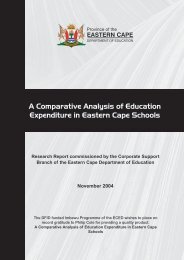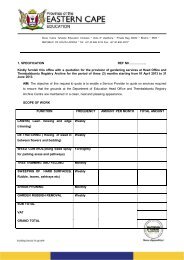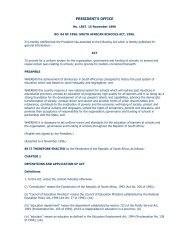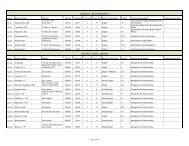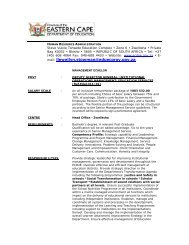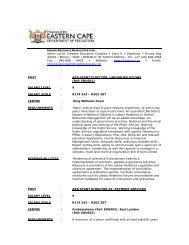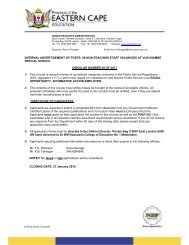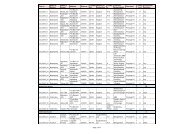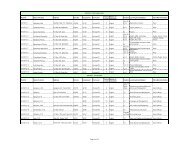part a: strategic overview - Department of Education
part a: strategic overview - Department of Education
part a: strategic overview - Department of Education
You also want an ePaper? Increase the reach of your titles
YUMPU automatically turns print PDFs into web optimized ePapers that Google loves.
decreasing trend. For all the years shown, the minimum repetition rate is to be found<br />
around grade 7 peaking in grades 10 and 11.<br />
The average repetition rate for all grades was 11% in both 1999 and 2000 and rose to<br />
12% in 2001 and 2002. The average rate has however started to decline in 2003 and is<br />
currently standing at 9%. In the Primary phase in 2002 Grades 1 and 4 had the highest<br />
repetition rates at 10%. In the secondary phase repetition rates were considerably higher<br />
and tended to peak in the higher grades, <strong>part</strong>icularly Grades 10 and 11. In 2002, one<br />
fifth <strong>of</strong> learners in Grades 10 and 11 repeated these grades. By Grade 12 the figure had<br />
dropped slightly to 16%.<br />
Table 24: Repetition Rate by Grade<br />
1998* 1999 2000 2001 2002 2003 2004 #<br />
G1 13% 10% 9% 10% 10% 7% N/A<br />
G2 12% 10% 8% 9% 9% 6% N/A<br />
G3 12% 10% 10% 10% 9% 6% N/A<br />
G4 13% 11% 11% 12% 10% 7% N/A<br />
G5 12% 10% 9% 10% 9% 6% N/A<br />
G6 10% 9% 8% 8% 7% 5% N/A<br />
G7 10% 9% 8% 7% 6% 5% N/A<br />
G8 16% 13% 13% 14% 8% 8% N/A<br />
G9 15% 12% 12% 13% 12% 7% N/A<br />
G10 23% 16% 18% 20% 20% 20% N/A<br />
G11 23% 17% 18% 22% 22% 19% N/A<br />
G12 27% 19% 18% 16% 16% 11% N/A<br />
Average 14% 11% 11% 12% 12% 9% N/A<br />
*Repetition Rates for 1998 are overestimated due to incomplete enrolment data for 1997. Repetition Rates for 2004<br />
is not yet available. 2005 Data still needs to be captured to calculate 2004.<br />
Table 25 and Graph 9 shows the drop-out rate per grade from 1999 to 2003. The<br />
number <strong>of</strong> dropouts in the schooling system in the Eastern Cape has steadily increased<br />
from 7% in 1999 to a high <strong>of</strong> 15% in 2000. From 2001 to 2003 it would seam that the<br />
dropout rate has stabilized at around 11%. Dropouts in the province have the tendency<br />
to peak in the early grades and then again in grades 10-12. This tendency is matched<br />
by the higher repetition rates shown earlier.<br />
Table 25: Drop-out Rate by Grade<br />
1999 2000 2001 2002 2003 2004* Average<br />
G1 15% 20% 25.19% 26.02% 23% N/A 22%<br />
G2 5% 13% 5.32% 6.44% 5% N/A 7%<br />
G3 4% 12% 6.87% 5.92% 4% N/A 7%<br />
G4 4% 12% 6.29% 8.85% 7% N/A 8%<br />
G5 4% 12% 7.48% 7.28% 7% N/A 8%<br />
G6 5% 12% 8.80% 8.13% 7% N/A 8%<br />
G7 1% 10% 8.87% 8.5% 7% N/A 7%<br />
G8 7% 15% 6.24% 14.97% 12% N/A 11%<br />
G9 5% 17% 17.92% 12.80% 2% N/A 11%<br />
G10 15% 23% 18.62% 17.76% 22% N/A 19%<br />
G11 15% 21% 13.02% 10.28% 23% N/A 16%<br />
Average 7% 15% 11% 12% 11% N/A 11%<br />
* 2004 drop out rate is not available. Data will be released after the capturing <strong>of</strong> the 2005 Annual Survey has been<br />
completed.<br />
5 Year ECDoE Strategic Plan for 2005/06 2005-06 to 2009/10 2009-10. March 21 F (4)Page 2006 75<br />
Page 79




